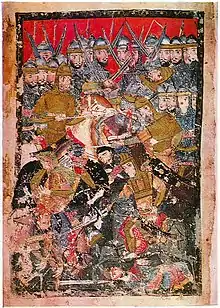Hadadezer
Hadadezer (/ˌhædəˈdiːzər/; "[the god] Hadad is help"[1]); also known as Adad-Idri (Akkadian: 𒀭𒅎𒀉𒊑, romanized: dIM-id-ri), and possibly the same as Bar-Hadad II (Aram.) or Ben-Hadad II (Heb.), was the king of Aram at Damascus between 865 and 842 BC.
| Hadadezer | |
|---|---|
 "Battle of the Israelites against King Hadadezer from a Georgian manuscript, 1665. | |
| King of Aram Damascus | |
| Reign | 865–842 BC |
| Predecessor | Ben-Hadad I |
| Successor | Hazael |
| Died | 842 BC |
| Issue | Suffocated by Hazael |
The Hebrew Bible states that Hadadezer (which the biblical text calls "Ben-Hadad", but different from Ben-Hadad I and Ben-Hadad III) engaged in war against king Ahab of Israel, but was defeated and captured by him; however, soon after that the two kings signed a peace treaty and established an alliance (1 Kings 20).
According to the Kurkh Monoliths, Hadadezer and Irhuleni of Hamath later led a coalition of eleven kings (including Ahab of Israel and Gindibu of the Arab) at the Battle of Qarqar against the Assyrian king Shalmaneser III. He fought Shalmaneser six other times, twice more with the aid of Irhuleni and with an unspecified coalition.
The biblical text reports that, after a few years, Ahab and king Jehoshaphat of Judah formed an alliance against Hadadezer, starting a war against him; however, the Aramean king was able to defeat them, and Ahab was killed during the battle (1 Kings 22).
According to the Bible (2 Kings 8) and to an inscription of the Assyrian king Shalmaneser III, Hadad-Ezer was succeeded by Hazael after his death.[2]
See also
Notes
- Bill T. Arnold; H. G. M. Williamson (26 October 2011). Dictionary of the Old Testament: Historical Books. InterVarsity Press. pp. 46–. ISBN 978-0-8308-6946-6.
- Grayson, A. (1996). Assyrian Rulers of the Early First Millennium BC II (858-745). Toronto: University of Toronto Press. p. 118. ISBN 0802008860.